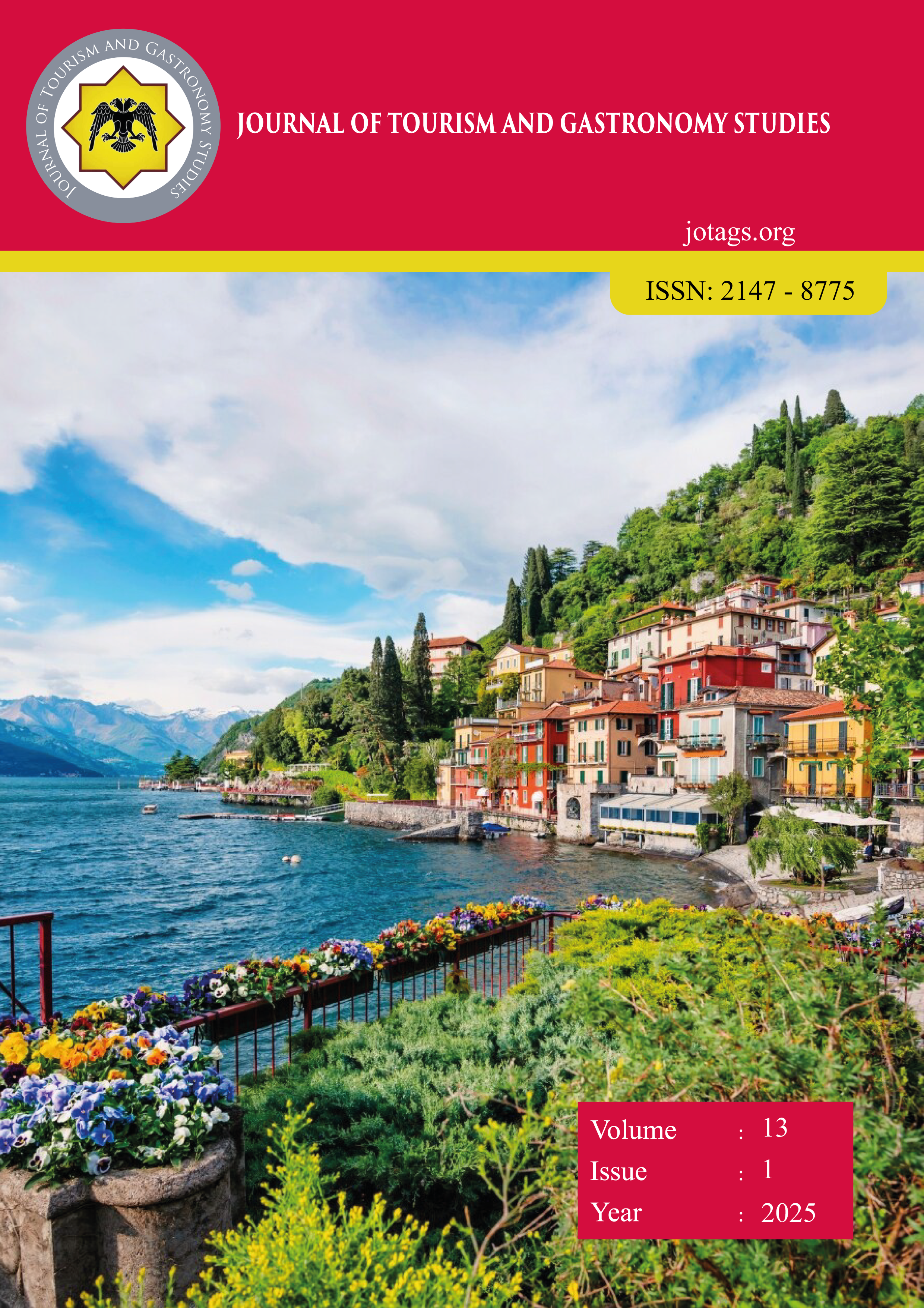Culinary Application of Artisan Chocolate Enriched with Spirulina and Sensorial Evaluation
DOI:
https://doi.org/10.21325/jotags.2025.1547Keywords:
Spirulina, Artisan chocolate, Functional food, Sensorial analysis, Culinary creativity, Tasting panelAbstract
Creativity in culinary practices goes beyond the methods used to include the use of new alternative food sources to improve the sustainability of the global food system. In this study, spirulina was used to develop artisanal chocolate products to be served in restaurants. Four different recipes were developed using dark, milk, and white chocolate drops in two different shapes: chocolate bars and hemispheres. The recipes were developed in two different ways: directly into the chocolate and as a filler. To achieve an optimal flavor profile, lemon and raspberry were chosen as pairings to mitigate any off-flavors associated with blue-green algae. The developed chocolate products were evaluated by a tasting panel of 15 semi-trained panelists. The chocolate samples were analyzed on a hedonic scale based on sensory attributes such as appearance, taste, smell, color, and texture, and the collected data was evaluated using rank analysis. The overall acceptance results showed that the dark chocolate filled with lemon ganache was perceived as acceptable compared to the other chocolates developed. The study also aimed to explore the potential of alternative food sources as a way to enhance culinary creativity in the restaurant environment.
References
AlFadhly, N. K., Alhelfi, N., Altemimi, A. B., Verma, D. K., Cacciola, F., & Narayanankutty, A. (2022). Trends and technological advancements in the possible food applications of Spirulina and their health benefits: A Review. Molecules, 27(17), 5584 https://doi.org/10.3390/molecules27175584.
Altuğ-Onoğur T, Elmacı Y. (2019). Sensorial Analysis of Food (Gıdalarda duyusal değerlendirme). Sidas Medya Publishing, Izmir, Turkiye, p. 31.
Almeida, L. M. R., da Silva Cruz, L. F., Machado, B. A. S., Nunes, I. L., Costa, J. A. V., de Souza Ferreira, E., .Lemos P.V.F. Druzzian J.I. & de Souza, C. O. (2021). Effect of the addition of Spirulina sp. biomass on the development and characterization of functional food. Algal Research, 58, 102387 https://doi.org/10.1016/j.algal.2021.102387.
Atik, D. S., Gürbüz, B., Bölük, E., & Palabıyık, İ. (2021). Development of vegan kefir fortified with Spirulina platensis. Food Bioscience, 42, 101050 https://doi.org/10.1016/j.fbio.2021.101050.
Barišić, V., Kopjar, M., Jozinović, A., Flanjak, I., Ačkar, Đ., Miličević, B., Šubarić, D., Jokić, S., & Babić, J. (2018). The Chemistry behind Chocolate Production. Molecules, 24(17), 3163. https://doi.org/10.3390/molecules24173163.
Bernaerts, T. M., Gheysen, L., Foubert, I., Hendrickx, M. E., & Van Loey, A. M. (2019). The potential of microalgae and their biopolymers as structuring ingredients in food: A review. Biotechnology Advances, 37(8), 107419 https://doi.org/10.1016/j.biotechadv.2019.107419.
Cadby, J., Araki, T., & Villacis, A. H. (2021). Breaking the mold: Craft chocolate makers prioritize quality, ethical and direct sourcing, and environmental welfare. Journal of Agriculture and Food Research, 4, 100122 https://doi.org/10.1016/j.jafr.2021.100122
Chen, J., Li, J., Dong, W., Zhang, X., Tyagi, R. D., Drogui, P., & Surampalli, R. Y. (2018). The potential of microalgae in biodiesel production. Renewable and Sustainable Energy Reviews, 90, 336-346. https://doi.org/10.1016/j.rser.2018.03.073.
da Silva, S. P., do Valle, A. F., & Perrone, D. (2021). Microencapsulated Spirulina maxima biomass as an ingredient for the production of nutritionally enriched and sensorially well-accepted vegan biscuits. Lwt, 142, 110997. https://doi.org/10.1016/j.lwt.2021.110997.
de Oliveira, T. T. B., dos Reis, I. M., de Souza, M. B., da Silva Bispo, E., Maciel, L. F., Druzian, J. I., Guimarães Tavares P.P.L, de Oliveira Cerqueira A., dos Santos Boa Morte E., Abreu Glória M.B., Lima Deus V., & de Santana, L. R. R. (2021). Microencapsulation of Spirulina sp. LEB-18 and its incorporation in chocolate milk: Properties and functional potential. Lwt, 148, 111674 https://doi.org/10.1016/j.lwt.2021.111674
Dinçoğlu, A. H., Akça, S. S., & Çalışkan, Z. (2024). Effect of Spirulina platensis on probiotic, nutritional, and quality properties of yogurt. International Food Research Journal, 31(1). https://doi.org/10.47836/ifrj.31.1.14.
Ekantari, N., Budhiyanti, S. A., Fitriya, W., Hamdan, A. B., & Riaty, C. (2019, November). Stability of chocolate bars fortified with nanocapsules carotenoid of Spirulina platensis. In IOP Conference Series: Earth and Environmental Science (Vol. 370, No. 1, p. 012079). IOP Publishing. DOI 10.1088/1755-1315/370/1/012079
El-Sharnouby, G., Abughoush, M., & Choudhury, I. (2024). Novel Development of Pasta Enriched with Spirulina platensis Microalgae: Biochemical and Histological Parameters. Jordan Journal of Agricultural Sciences, 20(1), 48–62. https://doi.org/10.35516/jjas.v20i1.1142.
Fanari, F., Comaposada, J., Boukid, F., Climent, E., Coma, A. C., Guerrero, L., & Castellari, M. (2023). Enhancing energy bars with microalgae: A study on nutritional, physicochemical and sensory properties. Journal of Functional Foods, 109, 105768 https://doi.org/10.1016/j.jff.2023.105768
Fantechi, T., Contini, C., & Casini, L. (2023). Pasta goes green: Consumer preferences for spirulina-enriched pasta in Italy. Algal Research, 75, 103275. https://doi.org/10.1016/j.algal.2023.103275.
Fanton, S., Cardozo, L. F., Combet, E., Shiels, P. G., Stenvinkel, P., Vieira, I. O., .Narciso H.M., Schmitz J., & Mafra, D. (2021). The sweet side of dark chocolate for chronic kidney disease patients. Clinical Nutrition, 40(1), 15-26 https://doi.org/10.1016/j.clnu.2020.06.039.
Fanzo, J., Rudie, C., Sigman, I., Grinspoon, S., Benton, T. G., Brown, M. E., Covic N., Fitch K., Golden C.D., Grace D., Hivert M.F., Huybers P., Jaacks L.M., Masters W.A., Nisbett N., Richardson R.A. , Singleton C.R., Webb P., & Willett, W. C. (2022). Sustainable food systems and nutrition in the 21st century: A report from the 22nd annual Harvard Nutrition Obesity Symposium. The American Journal of Clinical Nutrition, 115(1), 18-33 https://doi.org/10.1093/ajcn/nqab315 .
Fróna, D., Szenderák, J., & Harangi-Rákos, M. (2019). The challenge of feeding the world. Sustainability, 11(20), 5816 https://doi.org/10.3390/su11205816
Grahl, S., Strack, M., Weinrich, R., & Mörlein, D. (2018). Consumer‐Oriented Product Development: The Conceptualization of Novel Food Products Based on Spirulina (Arthrospira platensis) and Resulting Consumer Expectations. Journal of Food Quality, 2018(1), 1919482 https://doi.org/10.1155/2018/1919482.
Grobbelaar, J. U., & Bornman, C. H. (2004). Algal biotechnology: real opportunities for Africa. South African Journal of Botany, 70(1), 140-144. https://doi.org/10.1016/S0254-6299(15)30274-X.
Gün, D., Çelekli, A., Bozkurt, H., & Kaya, S. (2022). Optimization of biscuit enrichment with the incorporation of Arthrospira platensis: nutritional and sensory approach. Journal of Applied Phycology, 34(3), 1555-1563 https://doi.org/10.1007/s10811-022-02702-5.
Hamdan, A. B., Riaty, C., Fitriya, W., & Ekantari, N. (2020). Effects of nanoencapsulated carotenoid of Spirulina platensis on the sensory profiles of dark and milk chocolate. In E3S Web of Conferences (Vol. 147, p. 03022). EDP Sciences. https://doi.org/10.1051/e3sconf/202014703022
Hossain, M. N., Ranadheera, C. S., Fang, Z., & Ajlouni, S. (2020). Healthy chocolate enriched with probiotics: a review. Food Science and Technology, 41(3), 531-543 https://doi.org/10.1590/fst.11420 .
Ker, J. K., Lee, C. S., Chen, Y. C., & Chiang, M. C. (2023). Exploring Taiwanese Consumer Dietary Preferences for Various Vinegar Condiments: Novel Dietary Patterns across Diverse Cultural Contexts. Nutrients, 15(17), 3845 https://doi.org/10.3390/nu15173845.
Khadim, S. R., Mohanta, A., Maurya, P., Singh, P., & Asthana, R. K. (2021). Strategies for increased production of lipids and fine chemicals from commercially important microalgae. In Natural Bioactive Compounds R.p. Sinha & D.P. Häder (Eds) pp. 165-186. Academic Press. https://doi.org/10.1016/B978-0-12-820655-3.00008-2.
Koli, D. K., Rudra, S. G., Bhowmik, A., & Pabbi, S. (2022). Nutritional, functional, textural and sensory evaluation of Spirulina enriched green pasta: A potential dietary and health supplement. Foods, 11(7), 979. https://doi.org/10.3390/foods11070979
Lafarga, T., Fernández-Sevilla, J. M., González-López, C., & Acién-Fernández, F. G. (2020). Spirulina for the food and functional food industries. Food Research International, 137, 109356. https://doi.org/10.1016/j.foodres.2020.109356
Lucas, B. F., Costa, J. A. V., & Brunner, T. A. (2023). Attitudes of consumers toward Spirulina and açaí and their use as a food ingredient. LWT, 178, 114600 https://doi.org/10.1016/j.lwt.2023.114600.
Macdiarmid, J. I., Douglas, F., & Campbell, J. (2016). Eating like there's no tomorrow: Public awareness of the environmental impact of food and reluctance to eat less meat as part of a sustainable diet. Appetite, 96, 487-493 https://doi.org/10.1016/j.appet.2015.10.011
Mendes, M. C., Navalho, S., Ferreira, A., Paulino, C., Figueiredo, D., Silva, D., & Speranza, L. G. (2022). Algae as food in Europe: An overview of species diversity and their application. Foods, 11(13), 1871. https://doi.org/10.3390/foods11131871.
Montagna, M. T., Diella, G., Triggiano, F., Caponio, G. R., Giglio, O. D., Caggiano, G., & Portincasa, P. (2019). Chocolate,“food of the gods”: History, science, and human health. International Journal of Environmental Research and Public Health, 16(24), 4960 https://doi.org/10.3390/ijerph16244960.
Muhammad, D. R. A., Lemarcq, V., Alderweireldt, E., Vanoverberghe, P., Praseptiangga, D., Juvinal, J. G., & Dewettinck, K. (2020). Antioxidant activity and quality attributes of white chocolate incorporated with Cinnamomum burmannii Blume essential oil. Journal of Food Science and Technology, 57, 1731-1739 https://doi.org/10.1007/s13197-019-04206-6.
Muhammad, D.R.A., Fibri, D.L.N., Prakash, S. (2022). Improving the Functionality of Chocolate by Incorporating Vegetal Extracts. In: Galanakis, C.M. (eds) Trends in Sustainable Chocolate Production pp. 113–152. Springer, Cham. https://doi.org/10.1007/978-3-030-90169-1_4.
Nazir, F., Saeed, M., Abbas, A., Majeed, M. R., Israr, M., Zahid, H., & Nasir, M. (2022). Development, quality assessment and nutritive valorization of Spirulina platensis in yogurt spread. Food Science and Applied Biotechnology, 5(2), 106-118 https://doi.org/10.30721/fsab2022.v5.i2.173.
Nocella, C., Cavarretta, E., Fossati, C., Pigozzi, F., Quaranta, F., Peruzzi, M., De grandis F., Costa V., Sharp C., .Manara M., Nigro A., Cammisotto V., Castellani V, Picchio V., Sciarretta S., Frati G., Bartimoccia S., D’Amico A., & Carnevale, R. (2023). Dark Chocolate Intake Positively Modulates Gut Permeability in Elite Football Athletes: A Randomized Controlled Study. Nutrients, 15(19), 4203 https://doi.org/10.3390/nu15194203.
Özbal, B., Çelekli, A., Gün, D., & Bozkurt, H. (2022). Effect of Arthrospira platensis incorporation on nutritional and sensory attributes of white chocolate. International Journal of Gastronomy and Food Science, 28, 100544 https://doi.org/10.1016/j.ijgfs.2022.100544.
Pal AD, Chakraborty P, & Gandhi RJ (2024) Nutritional and Functional Properties of Prebiotic Enriched Chocolates. Indian Journal of Science and Technology 17(5), 426-435. https://doi.org/10.17485/IJST/v17i5.522
Pulz, O., & Gross, W. (2004). Valuable products from biotechnology of microalgae. Applied Microbiology and Biotechnology, 65, 635-648 https://doi.org/10.1007/s00253-004-1647-x.
Ramadhanti, N. E., Abrori, A., & Ekantari, N. (2021, November). Projective mapping of preferences on milk and dark chocolate bar fortified nanocapsules Arthrospira carotenoid. In IOP Conference Series: Earth and Environmental Science (Vol. 919, No. 1, p. 012031). IOP Publishing. DOI 10.1088/1755-1315/919/1/012031
Rose, H., Bakshi, S., Kanetkar, P., Lukose, S. J., Felix, J., Yadav, S. P., ... & Paswan, V. K. (2023). Development and Characterization of Cultured Buttermilk Fortified with Spirulina plantensis and Its Physico-Chemical and Functional Characteristics. Dairy, 4(2), 271-284 https://doi.org/10.3390/dairy4020019.
Salido, M., Soto, M., & Seoane, S. (2024). Seaweed: Nutritional and gastronomic perspective. A review. Algal Research, Vol 77, 103357 https://doi.org/10.1016/j.algal.2023.103357.
Samanta, S., Sarkar, T., Chakraborty, R., Rebezov, M., Shariati, M. A., Thiruvengadam, M., & Rengasamy, K. R. (2022). Dark chocolate: An overview of its biological activity, processing, and fortification approaches. Current Research in Food Science, 5, 1916-1943 https://doi.org/10.1016/j.crfs.2022.10.017.
Small, E. (2011). 37. Spirulina–food for the universe. Biodiversity, 12(4), 255-265 https://doi.org/10.1080/14888386.2011.642735.
Soni, R. A., Sudhakar, K., & Rana, R. S. (2017). Spirulina–From growth to nutritional product: A review. Trends in Food Science & Technology, 69, 157-171 https://doi.org/10.1016/j.tifs.2017.09.010.
Souiy, Z., Zakhama, N., Cheraief, I., & Hammami, M. (2022). Nutritional, physical, microbial, and sensory characteristics of gluten-and sugar-free cereal bar enriched with spirulina and flavored with neroli essential oil. LWT, 169, 113955. https://doi.org/10.1016/j.lwt.2022.113955
Stortz, T. A., & Marangoni, A. G. (2011). Heat resistant chocolate. Trends in Food Science & Technology, 22(5), 201-214. https://doi.org/10.1016/j.tifs.2011.02.001
Suganya, T., Varman, M., Masjuki, H. H., & Renganathan, S. (2016). Macroalgae and microalgae as a potential source for commercial applications along with biofuels production: a biorefinery approach. Renewable and Sustainable Energy Reviews, 55, 909-941. https://doi.org/10.1016/j.rser.2015.11.026
Şahin, O. I. (2020). Functional and sensorial properties of cookies enriched with SPIRULINA and DUNALIELLA biomass. Journal of Food Science and Technology, 57, 3639-3646 https://doi.org/10.1007/s13197-020-04396-4.
Tan, T. Y. C., Lim, X. Y., Yeo, J. H. H., Lee, S. W. H., & Lai, N. M. (2021). The health effects of chocolate and cocoa: A systematic review. Nutrients, 13(9), 2909 https://doi.org/10.3390/nu13092909.
Tiepo, C. B. V., Gottardo, F. M., Mortari, L. M., Bertol, C. D., Reinehr, C. O., & Colla, L. M. (2021). Addition of Spirulina platensis in handmade ice cream: Physicochemical and sensory effects Brazilian Journal of Development, 7(9), 88106–88123. https://doi.org/10.34117/bjdv7n9-121
Vasanthakumar, A. H., Sharan, J., & Cruz, A. M. (2016). Plaque pH and dental retention after consumption of different types of chocolates. Int J Clin Prev Dent, 12(2), 97-102 http://dx.doi.org/10.15236/ijcpd.2016.12.2.97.
Zugravu, C., & Otelea, M. R. (2019). Dark chocolate: To eat or not to eat? A review. Journal of AOAC International, 102(5), 1388-1396 https://doi.org/10.1093/jaoac/102.5.1388.
Published
How to Cite
Issue
Section
License
Copyright (c) 2025 Journal of Tourism & Gastronomy Studies

This work is licensed under a Creative Commons Attribution-NonCommercial 4.0 International License.








